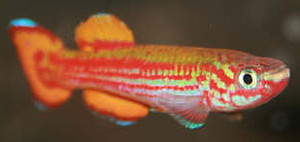Aphyosemion primigenium Radda & Huber 1977

A.primigenium. Photo courtesy of Peter Venstermans
| Meaning of Name |
Primitive (considered to be the ancestor of the striatum group). |
|||||||||||||||||||||||||||
| First Description |
Radda A.C. & Huber J.H. 1977. Cyprinodontidae Studien aus Gabun V - Das Tiefland West Gabun und die Mayumbe Berge. Aquaria 24 : p 138-146, figure 1, map. Also published in a BKA seperatum in English. |
|||||||||||||||||||||||||||
| Size |
4.5 cm |
|||||||||||||||||||||||||||
| Meristics |
D = 12-13, A = 14-15, D/A = +5-6, ll = 29-31+2-3) (Radda & Huber 1977). |
|||||||||||||||||||||||||||
| Karyotype |
n = 11, A = 21 (Scheel 1981. |
|||||||||||||||||||||||||||
| Sub-Genus |
Mesoaphyosemion |
|||||||||||||||||||||||||||
| Group |
striatum |
|||||||||||||||||||||||||||
| Synonyms |
None |
|||||||||||||||||||||||||||
Populations
|
A.primigenium
circulating in the US around 1980. Could this be G 76/27 ? G 76 -
Collected by Radda, Pürzl &
Huber, Gabon 1976. Collected at locations 23, 24, 25 & 27.
G 80 / 1 -
GBN 88 / 6 - Small stream
crossing the road, 20 kms southwest of Mbadi towards Moabi. Bamboo
forested area of average height. Deepest part was 1 metre. A 10 metre
length was blocked off for fishing. Fish collected were Plataplochilus
chalcopyrus, Epiplatys singa, E.huberi, Ctenopoma nanum, Chromidotilapia
sp., Hemichromis elongatus, Barbus sp. Five
blotches, B.cf.holotaenia,
B.cf.guirali &
Aphyosemion primigenium.
GBN 88 / 7 - Likely to be located between location GBN 88 / 6 & Moabi. Bitter comments that this collection was 'intense red'. GBN 88 / 8 - Stream east of Moabi.
GBN 88 / 10 - Stream, 100·5
kms from the Mbadi crossroads in the direction of Tchibanga. Between
the villages of Mourindi & Boukalou.
GBN 88 / 16 - Stream 30·5 kms from Tchibanga in the direction of Ndendé. Bitter reports these similar to those collected at Lebama. GEB 94 / 21 - Stream, located a few kms west of Bandi towards Mouila. Intense yellow colouration in unpaired fins. Eberl commented that this was a prolific population based on observations by Thomas Blum who had wild fish to breed with.
GJP 80 / 1 - GJS 00 / 18 - Kanda - A large fish collected at an altitude of 240 metres. Small stream. A.primigenium were large & numerous.
GJS 00 / 26 - Bandi - Stream called the Modyambi in the middle of the village, crossing the road. This was a place the women wash there clothes. Fish collecting was done on the opposite side of the road. Water temperature 22°C, pH 6·2, conductivity 43 µs. Elevation 200 metres.
Lébamba - A city close to the Ngounie River, Gabon.
|
|||||||||||||||||||||||||||
| Type Locality |
A brook which feeds the Douano River subsystem (Nyanga), close to Banyanga in the Mayumbe Mountains rainforest (altitude 250m). JH 76 / 27. |
|||||||||||||||||||||||||||
| Distribution |
Southwestern Gabon in the Nyanga & Dole-N'-Gounie River drainages between Mouila & Bdede-Lébamba. |
|||||||||||||||||||||||||||
| Habitat |
Small rainforest brooks. I have readings taken at a biotope but don't know which one. Water temperature 19·5 - 24·3°C, conductivity 22-96 µ, 0·25 - 2·35°DH. Syntopic species include E.multifasciatus, E.ansorgii, Plataplocheilus sp., Ctenopoma sp., Barbus holotaenia, Barbus sp., Hemichromis fasciatus & Nannocharax sp.
GJS 00 / 19
- Lebamba - Ndendé |
|||||||||||||||||||||||||||
| Distinguishing Characteristics | ||||||||||||||||||||||||||||
| Colour/Pattern Variability | Medium | |||||||||||||||||||||||||||
| History |
It was imported in 1980 but little is known about
imports up to 1990 where Friedrich Bitter records in BKA Killi-News
No.293 (Feb.1990) a collection. The collection area at this time is
only accessible by 2 decent roads; the N1 isfairly wide for a length
of around 200 kms, connecting Libreville along the coast with towns
to the south. |
|||||||||||||||||||||||||||
| Breeding Notes |
I have kept various populations over the years - G 80/1, GBN 88/8, GBN 88/10. I had harder water at DH 10 & they spawned OK in this. Always managed to raise some fry on. Jaroslav Kadlec in BKA No.357, June 1995 writes
a breeding report - Water used for breeding was harder than normal at
8DH, carbonate hardness up to 5. Water temperature 22-25°C. Incubation
of eggs in water took 14-30 days depending on temperature. Cooler water
prolongs hatching. Newly hatched fry are 4·2 - 4·3 mm
in length & are transparent & tea coloured. Newly hatched brine
shrimp was taken as a first food. Mr.K.Szafranek in DKG Journal 22 (3), May 1990 reported storing eggs in moist peat for 21 days. Steve Davidson in BKA newsletter No.417, June 2000 reported having a lot of eggs fungus in water incubation & had very few fungus when stored on damp peat. Eggs are misted with water now & again. Incubation was 18 days using this method. Fry were able to take newly hatched brine shrimp. Growth rate was slow but steady. Wolfgang Eberl reported results from Thomas Blum
in BKA newsletter No.497, February 2007. He starts with GBN 88 / 8 -
bred in 3 ways. First method used spawning mops. Water was pH 6·5,
hardness 10° German, temperature 22°C. Salt was added at 1 teaspoon
per 10 litres. Over 3 days eggs from 2 pairs yielded 44, 18 & 24
eggs. Eggs removed & water stored with some Cilex anti fungal treatment.
First fry hatched after 16 days & the last after 22 days. Hatching
rate was 80%. Fry mortalities due to not being able to escape the egg
shell. |
|||||||||||||||||||||||||||
| Diameter of Egg | ||||||||||||||||||||||||||||
| Remarks |
I found this sp. particularly susceptible to dropsy. Other aquarists keeping this sp. have had similar experiences. This is a sp. which does best in clean aquaria with regular water changes. |